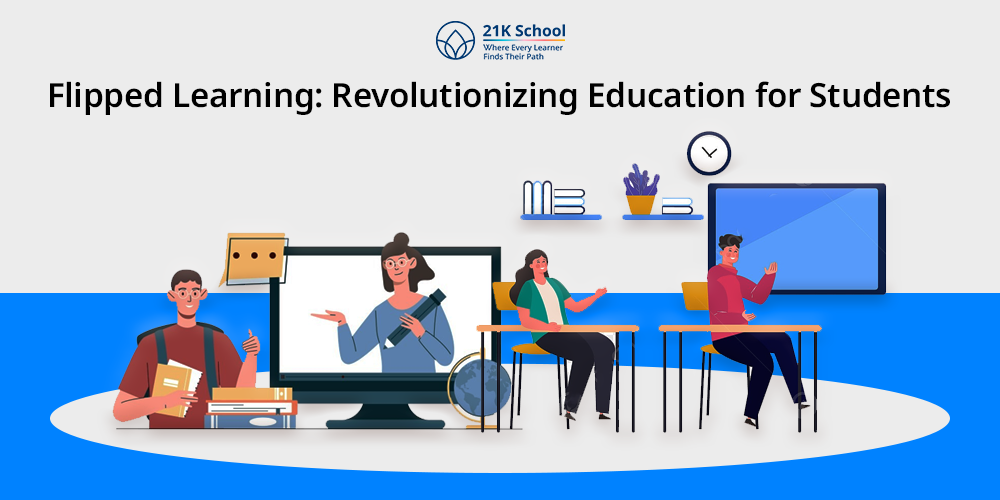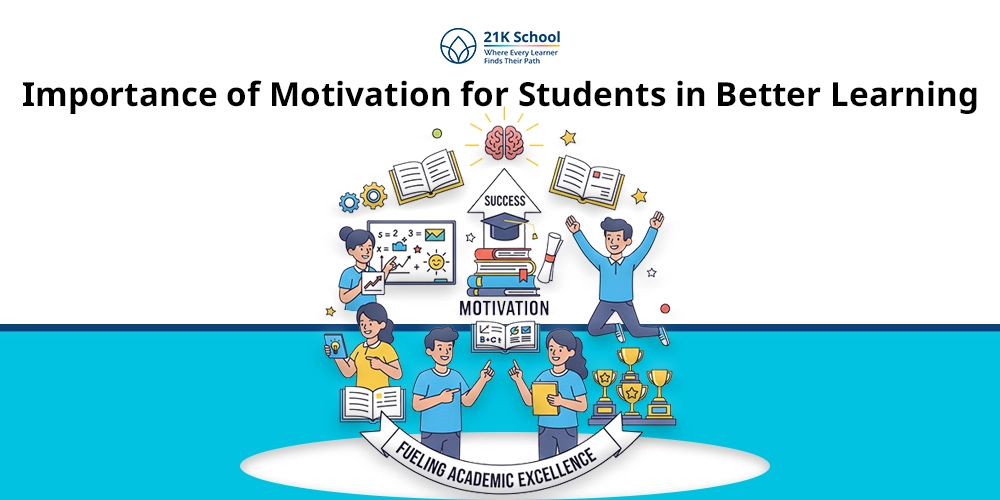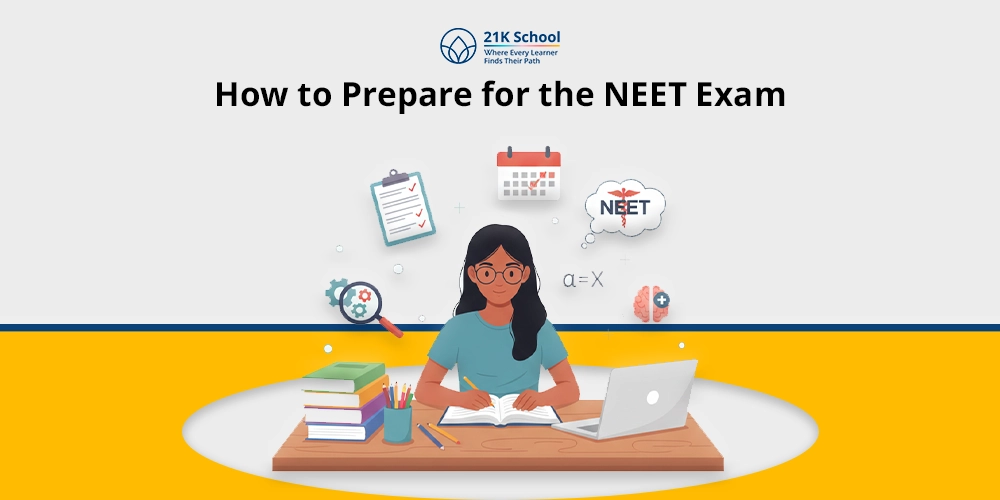
Have you ever thought that after going through a long lecture students find themselves confused while doing homework?
If yes, you are not alone. There are many students dealing with the same problem which can be resolved by flipped learning techniques.
Imagine a classroom where learning is not about sitting and listening to the whole chapter. However, spending time doing activities, discussing the concepts, and discovering new ways to learn.
Sounds different, right? That’s because it is different from traditional learning. Let’s explore everything about flipped learning and why it is crucial.
Contents
- What Is Flipped Learning?
- Flipped Learning Model
- How Does Flipped Learning Work?
- Core Components of a Flipped Classroom
- Flipped Learning Examples
- Benefits of Flipped Learning
- Challenges and Solutions of Flipped Learning in Education
- Key Difference: Flipped Learning V/S Blended Learning
- Blended Learning V/S Flipped Classroom
- How can Online Schools make Flipped Learning a Success?
- The Future of Flipped Learning
- Tips for a Successful Flipped Online Classrooms
- Conclusion & Takeaways
What Is Flipped Learning?
Flipped learning is a 21st century teaching method where students access new material outside of class. For example video lectures or readings. Then use class time for interactive activities and problem solving
It is also referred to as a pedagogical approach in which direct instruction moves from the group learning space to the individual learning space.
The result is group space is transformed into a dynamic, interactive learning environment for students.
Flipped learning technique also helps teachers to utilize class time more effectively, focusing on higher-level thinking skills and personalized guidance.
Flipped Learning Model
Flipped Learning Model includes changing traditional classroom where lectures happen and homework involves applying concepts, to a format where students engage with content outside of class.
It simply means use class time for collaborative activities and personalized learning to give change to students.
Explore the benefits of personalized learning in students life.
These models are also popular as key features or principles of flipped learning. Here’s a more detailed look at the flipped learning model:
1. Content Delivery
Content delivery means students engage with new material outside of class. It can be done often through videos or online resources.
Class time is then dedicated to active learning through discussions, collaborative projects, and hands-on problem-solving activities.
This approach directly turns the table where content is delivered in class and homework is used for practice.
2. Class Time for Engagement
In the flipped learning model traditional class time flipped into activities like discussions, problem-solving, and collaborative work for student engagement
By making class time more engaging, the approach allows students to apply concepts and interact with peers and the teacher during class.
3. Active Learning
Instead of passively receiving information flipped learning works as an active learning for students in class. For example:
Active learning replaces direct instruction like lectures from the classroom to before class, allowing for more active, engaged learning during class time.
This helps students in collaborative work, and deeper understanding through debates, discussions, and group projects.
4. Student-Centered
In this model student-centered approach to education the focus shifts to individual student needs and learning styles, allowing for more flexibility and personalization.
This empowers students to take greater ownership of their learning while enabling teachers to provide more effective guidance and support.
How Does Flipped Learning Work?
Flipped Learning in today’s education refers to inverts the conventional classroom model by delivering instructional content outside of class and moving activities.
This brings activities that were traditionally assigned as homework into the classroom setting.
This method fosters a more interactive and student-centered learning environment, encouraging active participation and deeper understanding.
The practice of flipped online learning involves three parts: Pre-Class Learning, In-Class Active Learning and Teacher as Facilitator.
Let’s understand how it works:
1. Pre-Class Learning
In pre-class learning students access instructional materials, such as video lectures, readings, or interactive modules, outside of class time.
This self-paced learning allows students to absorb new information at their own speed.
2. In-Class Active Learning
In-class active learning class time is dedicated to activities that reinforce and apply the pre-learned content.
These may include group discussions, problem-solving exercises, case studies, or hands-on projects.
3. Teacher as Facilitator
Here the teacher acts as a facilitator, providing support and addressing individual student needs. It is very crucial for both teachers and students.
Core Components of a Flipped Classroom
Flipped classrooms have some core components such as pre-class learning activities and in-class active learning.
Let’s get into a more detailed look at the key components:
1. Pre-Class Learning
Pre-class learning means delivering core content to students outside of the traditional classroom setting, through videos, readings, or online modules.
This helps kids in problem-solving, discussions, and group projects rather than listening concepts.
2. In-Class Active Learning
One of the core components to in-class active learning is applying concepts learned outside of class through discussions, problem-solving, and collaborative projects.
Various activities that promote critical thinking and collaboration foster real creativity and deeper comprehension.
Learn how to develop critical thinking skills in students.
3. Formative Assessment
Formative assessment in flipped classroom gauging student understanding of pre-class material and guiding learning during in-class activities.
Monitoring student progress and providing immediate feedback through quizzes, peer reviews, and reflective journals is ideal.
4. Technology Integration
Technology plays a crucial role in flipped classrooms, for example the use of video lectures for pre-class learning, interactive tools for assessments, and LMS to facilitate communication and content sharing.
This leads to encouraging curiosity, access to materials and enabling interactive learning experiences.
5. Student-Centered Approach
Student-centered approach such as pre-recorded lectures or resources accessed before class, self-paced learning, active participation, and collaborative activities.
This helps in encouraging learners to take responsibility for their education.
6. Flexible Learning Environment
Flexible learning environment means both physical and virtual classroom environments which are designed to support diverse learning activities.
This includes areas arranged for group work and discussions, access to devices and internet connectivity for interactive learning and quiet zones to study.
7. Intentional Content
Intentional content means careful selection and design of materials for both pre-class and in-class activities.
Here students can learn the best suited for independent learning before class and maximizing in-class time for engaging activities.
8. Professional Educator
Professional educator helps kids change the focus from traditional in-class lectures to pre-class learning. This is done often through videos, readings, or online modules.
Educator responsibilities included here are guiding learning, providing feedback and reflecting on practice.
9. Communication and Feedback
Communication and feedback are two crucial components which can’t be neglected. Effective communication ensures students understand the flipped classroom correctly.
Feedback, both from the instructor and peers, helps students monitor their progress and leads to improvement in future.
Flipped Learning Examples
Examples will help you to understand how to implement flipped learning in the classroom and why it is important and should be a part of modern education.
1. Science Lab Preparation
In the traditional method of learning, the teacher explains the theory in class, students do lab work afterward.
While in a new approach students watch a video explaining the lab procedure and underlying scientific concepts at home.
In class, they start to perform the experiment, having already understood the “why” and “how.”
2. Math Problem-Solving Workshops
In early days maths problem-solving workshops start by lecture in class, homework includes solving problems.
However now with new methods students watch mini-lessons or tutorials covering new math concepts at home.
And later in class, they work in groups solving challenging problems or projects with the teacher guiding and coaching.
3. History Roleplay
History roleplay is an ideal example in which earlier teachers lecture on historical events in the classroom. And kids need to listen carefully.
On the other hand, now students watch short documentary clips or read or view multimedia historical sources at home.
In class, they take part in a historical roleplay or debate. For example Congress during the Civil Rights Movement or the Treaty of Versailles.
Benefits of Flipped Learning
There are many advantages of flipped learning in today’s 21st century classrooms.
From enhanced student engagement, increased collaboration, and greater access to learning materials at a student’s own pace. Let’s understand each of these:
1. Personalized Learning
Personalized learning is an educational approach that tailors instruction to align with each student’s unique needs, strengths, and interests.
Students can tailor their learning experiences by engaging with materials at their own pace, allowing for better comprehension and retention.
2. Independent Learning Skills
Independent Learning Skills means students learn the basic concepts independently in the home often through video content.
This helps them to get used to the process of self-study and allows them to learn at their own pace.
3. Reduced Stress
In the classroom students review materials they need and provide support. Flipped Learning can alleviate anxiety associated with traditional homework and assessments.
It allows independent learning with confidence which improves critical thinking skills.
4. Increased Student-Teacher Interaction
This kind of learning promotes student-teacher interaction by providing more one-on-one time with teachers.
Here teachers understand each student’s requirements, provide personalized guidance, and clarify topics in a more tailored manner.
5. Opportunity for Differentiated Instruction
Differentiated instruction is a teaching approach that tailors instruction to meet the diverse learning needs of individual students, even when the learning goal remains the same for all.
Educators can tailor in-class activities to accommodate diverse learning styles and abilities, ensuring that all students are supported.
Challenges and Solutions of Flipped Learning in Education
Everything comes up with less to more challenges and to overcome each one we need to understand and find the best solutions.
Here how plenty of challenge and solutions for making flipped online learning easy and impactful:
1. Equity and Access
As we know flipped learning provides personalized learning and increased student engagement. However it also faces equity and access challenges.
Solution:
Equal access to technology provided by schools such as devices and internet access, and offer alternative options for accessing materials, like offline resources or extended library hours.
2. Effective Online Material Design
This kind of learning needs well-designed online materials which requires a lot of time, patience and expertise. This can be a hectic task.
Solution:
To resolve this problem teachers can collaborate to share resources and best practices. And utilize available tools and platforms that facilitate content creation.
3. Student Self-Direction
This kind of education promotes self-directed learning, but also faces challenges like self-discipline.
Solution:
To overcome this challenge teachers can provide guidance on time management and study skills, and incorporate regular check-ins to monitor progress and provide support.
Key Difference: Flipped Learning V/S Blended Learning
Its time go deep and understand the difference between flipped learning and blended learning:
| S.No. | Particulars | Flipped Learning | Blended Learning |
| 1. | Definition | In flipped learning students first discover new concepts at home through videos or readings. Class time is then dedicated to hands-on activities and in-depth discussions. | Blended learning combines in-person classroom instruction with online educational activities to create a more flexible and integrated learning experience. Here both components are interwoven throughout the course. |
| 2. | Use of Class Time | In this type class time is reserved for application, problem-solving, and interactive activities. | Here the class time of students can still include lectures, but it’s supplemented by online resources. |
| 3. | Learning Flow | Flipped learning begins outside the classroom and continues inside. | In blended learning it occurs both inside and outside the classroom one by one. |
| 4. | Content Delivery | Content delivery here primarily online before class. | Content delivery in blended learning is online and in-person throughout the course. |
| 5. | Flexibility | Flexibility is limited in scheduling. | Blended learning has high flexibility in scheduling and access to content. |
Blended Learning V/S Flipped Classroom
Understanding the key difference between blended learning and flipped classroom:
| S.No. | Particulars | Flipped Classroom | Blended Learning |
| 1. | Definition | In flipped classroom students study concepts at home and do practice in class. | Blended learning integrates both online and in-person instruction in a balanced, alternating format. |
| 2. | Learning Location | Content is learned at home; class time is for application. | Both online and in-person components are integrated. |
| 3. | Technology Use | Technology is used primarily for delivering lessons before class. | Here ongoing use of technology like digital tools used throughout the course. |
| 4. | Content Delivery | Flipped classrooms aim at delivering new content online. | In blended learning, content can be delivered in various formats. This includes both online and in-person. |
| 5. | Example | A flipped computer science class where students watch coding tutorials at home and then apply those skills in a classroom project. | A high school science course where students learn online modules and video lessons at home, then conduct science experiments in classroom. |
How can Online Schools make Flipped Learning a Success?
For successful implementation of flipped learning in students’ lives by online school, we need to focus on some key points.
Focus on pre-class engagement through diverse learning materials, active learning during class time, and effective feedback mechanisms.
Here is a detailed breakdown one must read:
1. Prepare Engaging Pre-Class Materials
By creating short, focused videos that introduce key concepts, use of interactive tools for student engagement and provide supplementary resources for discovering can be helpful.
Implementation of these points helps teachers to prepare engaging pre-class materials for students.
2. Foster Active Learning During Live Sessions
Fostering active learning during live sessions leverages pre-class material to enhance student engagement and deepen understanding.
This helps students for continuous learning with interest and curiosity during flipped classroom.
3. Leverage Technology Effectively
Leverage technology effectively includes Learning Management Systems, use platforms like Zoom, Microsoft Teams, or Google Meet for conferences.
Teachers also use online assessment tools to survey and assess student learning.
4. Encourage Student Engagement and Collaboration
To encourage student engagement and collaboration, focus on interactive pre-class materials, facilitating meaningful in-class activities that promote collaboration and student-led learning, and providing timely feedback.
It aims to foster deeper learning and stronger student connections among students during class.
5. Provide Real-Time Feedback
Use polls, breakout room observations, and instant grading tools to provide real-time feedback.
Helpful feedback that guides students in enhancing their understanding and developing their skills.
The Future of Flipped Learning
With the increasing need of AI, personalized learning paths, and interactive tools in education, the flipped model is evolving in many ways.
From AI-driven content recommendations, gamified pre-class learning, advanced analytics to inform instruction to greater global access to high-quality instruction etc.
Let’s elaborate:
1. Technology Integration
Technology integration means using interactive whiteboards, online platforms like 21k school and virtual reality to create immersive learning experiences.
Technology in the 21st century provides more engaging, personalized, and flexible learning experiences for both teachers and students.
2. Expanding into New Areas
With the help of secondary education and rural populations flipped classrooms are expanding into new areas.
Beyond traditional subjects students can also expand into new areas that improve their problem solving skills, critical thinking and social emotional learning.
It’s time to improve kids skills by reading how to improve problem solving skills in students.
3. Active Learning and Deeper Understanding
Active learning and deeper understanding includes higher-order thinking, active engagement and student responsibility which foster their learning.
This makes it a promising approach for the future of education of students.
Tips for a Successful Flipped Online Classrooms
For a successful flipped online classroom environment one needs to focus on various things.
From student engagement, providing diverse resources, to using technology effectively to facilitate learning.
Here’s the detail look:
- Start Slowly: Start slowly by gradually integrating pre-class activities and in-class interactive learning. Students advised to begin with a single unit or topic using the flipped model to ease students into the structure.
- Clear Pre-Class Materials: A right classroom with clear pre-class materials, focus on clarity, accessibility, and engagement. It’s important to ensure materials are short, purposeful, and accessible. Provide guiding questions or a viewing checklist.
- In-Class Activities: To ensure successful flipped online classrooms with clear pre-class materials, focus on clarity, accessibility, and engagement. Focus on higher-order tasks such as analyzing, creating, evaluating and making them collaborative.
- Encourage Active Learning: Teachers can promote engagement through polls, problem-solving tasks, simulations, or case studies. This will improve the engagement and build curiosity in students.
- Transparency and Clear Communication: Transparency and clear communication is crucial to outline expectations, deadlines, and goals clearly. Use rubrics and feedback forms regularly.
Conclusion & Takeaways
Flipped learning helps in enhancing educational delivery that’s why it is an ideal approach used by most of the schools like 21K school.
In an online school setting, flipped learning can thrive with well-designed content, strategic use of technology, and a focus on engagement and active participation.
By starting small and scaling gradually, educators can transform passive learning into an engaging, student-centered experience.


